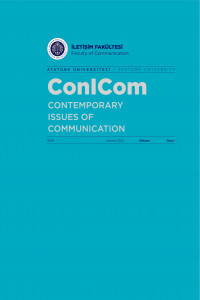Graffiti as a Communication Tool and Use of Experimental Graphic Design in Graffiti Applications
Graffiti as a Communication Tool and Use of Experimental Graphic Design in Graffiti Applications
Graffiti, which emerged in New York in the 1960s-70s with the writing activities of young people to prove their existence, evolved into an original, free and aesthetic art, street art, by diversifying with different techniques, technologies, and styles. This study deals with the reflections of experimental graphic design practices in street art. In addition, this study deals with the reviews of practical graphic design practices in street art. Finally, the study, which aims to reveal the application areas, diversity, and effectiveness of experimental graphic design in street art, answers the questions of what experimentalism corresponds to in design, whether street art and graphic design interact, and how this interaction affects street art. A qualitative research design was used in the study, and the graffiti sampled over the concepts distilled from the literature were subjected to descriptive analysis. The findings show that 3D illustrations are at the forefront beyond realistic illustrations in today’s graffiti applications.
Keywords:
Street art, Graffiti, Experimental graphic Design, Communication,
___
- Ambrose, G. & Harris, P. (2019). Grafik tasarımda tasarım fikri (2. Edition). A. Güler Taşçıoğlu ve Melike Taşçıoğlu (trans.). İstanbul: Literatür.
- Bahar, T. vd. (2014). Duvarların dili: graffiti/sokak sanatı. İstanbul: Pera Müzesi.
- Balamer, B. (2015). Baskı resim ve sokak sanatı. [Unpublished master thesis], Anadolu Üniversitesi, Güzel Sanatlar Enstitüsü.
- Becer, E. (2015). İletişim ve grafik tasarım. Ankara: Dost Kitabevi.
- Bernard, M. (2010). Sanat, tasarım ve görsel kültür. Güliz Korkmaz (trans.). Ankara: Ütopya.
- Ciric, R. (2014). Deneysel eksilibris: ex-librist, International Journal of Ex-Libris, 1(1),10-14.
- Heller, S. ve Vienne, V. (2016). Grafik tasarımı değiştiren 100 fikir. Bengisu Bayrak (trans.). İstanbul: Literatür.
- Laratte, Ü, E. (2019) Deneysel ekslibris ve yeni yaklaşımlar. International Journal of Ex-libris. 6(10), 188-194.
- Okur, Ç. (2003). Deneysel tipografinin görsel iletişime etkisi. [Unpublished master thesis], Anadolu Üniversitesi Sosyal Bilimler Enstitüsü.
- Sarıkaya, R, (2018). Tipografik bir saldırı veya dışavurum olarak graffitinin dili. SDÜ Art-E Güzel Sanatlar Fakültesi Dergisi, 11(18), 230-251.
- Soteriou, H. (2012). “Logan Hicks”, Juxtapoz Magazine, 140, 70-79.
- Başlangıç: 2022
- Yayıncı: Atatürk Üniversitesi
